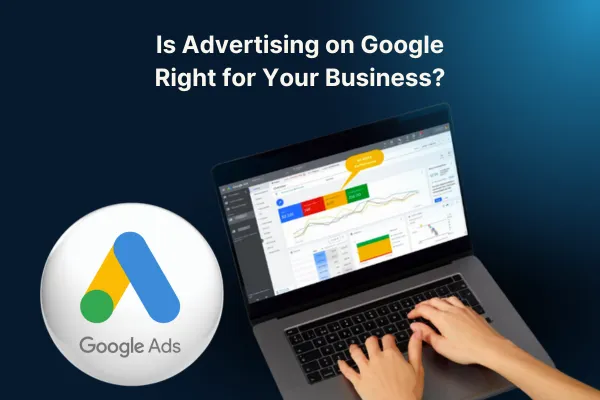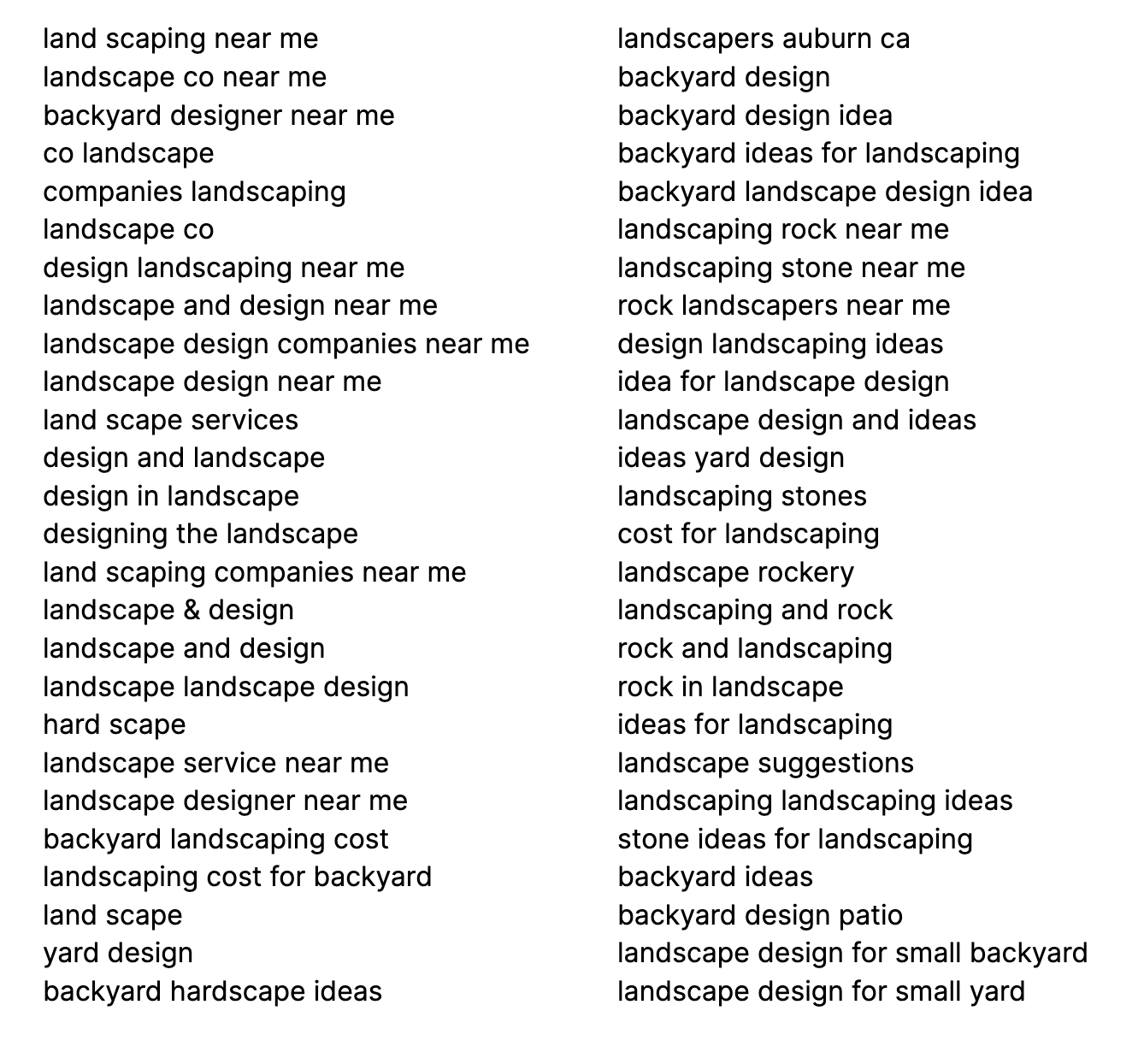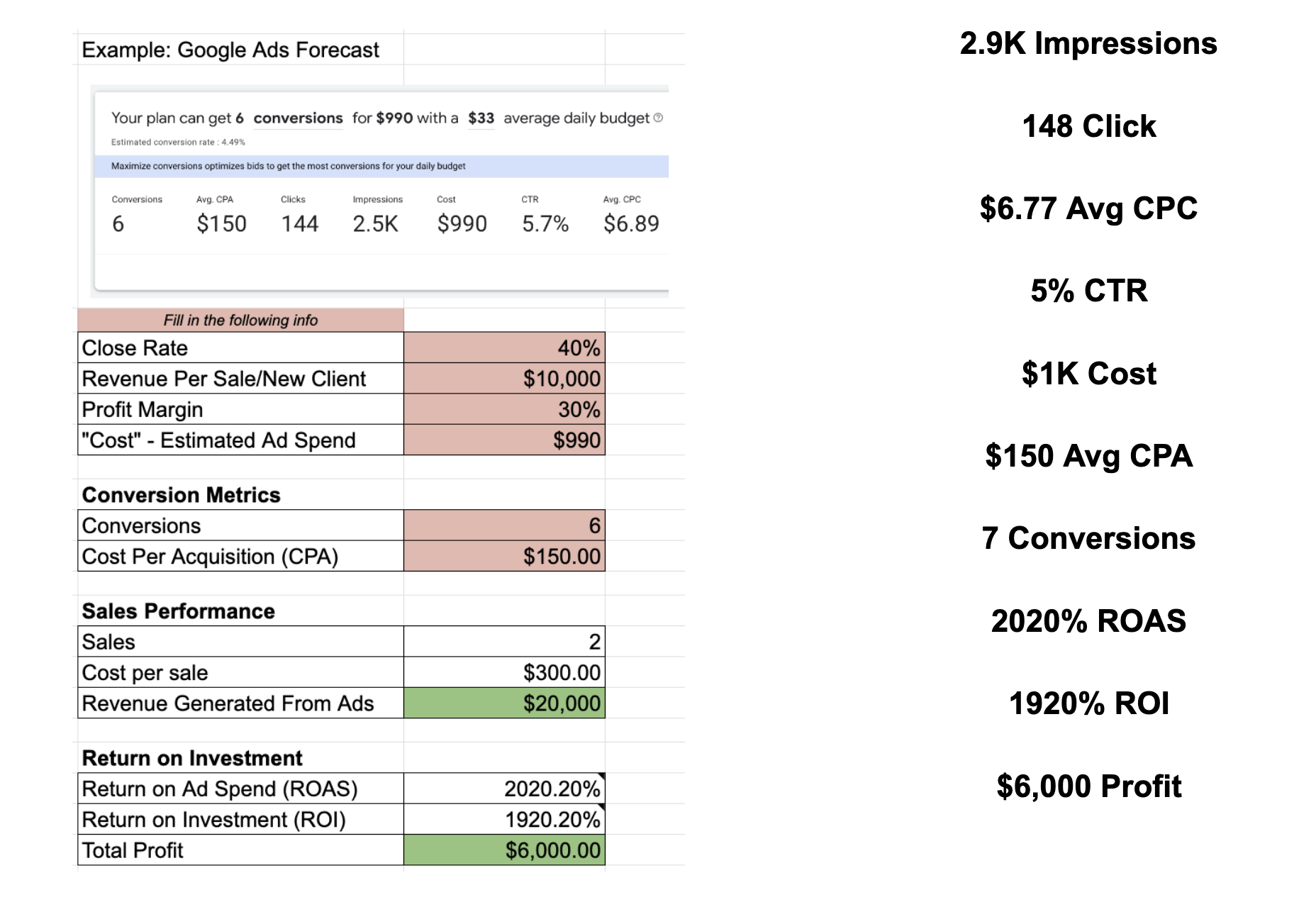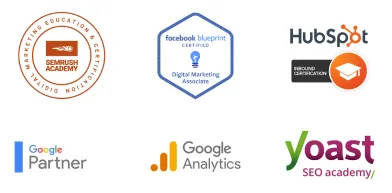TO LEARN IS TO GROW
Learning Center
We do our research and publish our results. Should probably call this the Growing Center.


Is Advertising on Google Right for Your Business?
We get asked all the time how much our marketing services cost.
While it’s true LOJO has a standard pricing sheet for the amount paid each month for a particular service, I always find myself trying to explain the process to hopefully shift the inquirer’s perspective from focusing solely on the cost of marketing services to considering whether or not they are a good investment.
This is especially true when it comes to advertising on Google. There are a lot of misconceptions and partial bits of knowledge when it comes to how Google ads work.
The best way to explain is with an example.
Should you be on Google?
If your ideal customer searches for services online, it's a good idea to have a presence on Google. When they “Google” what companies are in the area that can help them, you want to be a prominent option.
One of the best ways to “be on Google” is through paid ads, otherwise known as pay-per-click (PPC). Some of your challenges might be that you don't know much about how Google ads work. You know your competitors with deeper pockets are out there advertising, and you don't have a huge budget to compete head-to-head. You may not even know how much you could or should expect to pay for these ads. You may also have heard that “Google ads can be expensive.”
There is definitely a bit of truth to each of these challenges; however, the bottom line is that when Google ads are done right, they will yield a healthy return on your investment and are a reliable and scalable tool to grow your business.
How To Determine if Google Ads Is Right for You
Let me show you how to know if advertising on Google is right for your business with a hypothetical example of a Landscaping Firm. You will need the answers to the following data points to formulate an estimate of Return On Ad Spend (ROAS) and Return on Investment (ROI).
#1 What is the average value of a client?
Example: Average value of a client is $10,000
This can be hard to determine for a landscaper because you may have jobs that are $5,000, and you may close a deal worth $50,000.
A couple of ways to estimate this would be to find the mean, median, or mode.
Mean: Take the total number of jobs in a time period and the total revenue dollars generated and divide the two to get the average (mean) value.
Median: Take the highest and lowest job dollars and find the middle ground (median).
Mode: Identify the dollar amount of the most frequent types of jobs that are around the same value.
Whatever method you are using, I recommend weeding out the obvious anomalies before doing the math to give you a more accurate number.
#2 What is your closer rate?
Example: Closer rate 40%
Closer rate is a pretty straightforward number. If you track the number of leads/inquiries you receive and divide that by the number of jobs you end up doing, you will get your closer percentage.
If you don't have these numbers, you can estimate how many jobs you would close out of 10 non-referred customers who contact you.
I make the note about non-referred customers because the reality is those who find you through Google ads most likely will not be familiar with your business or have a pre-disposed bias one way or the other.
#3 What is your profit margin?
Example: Profit margin 30%
After you subtract all your costs and expenses from a job, what percentage of the total dollars paid are you left with?
#4 What geographic area do you service?
Example: Auburn, Rocklin, Roseville, Granite Bay, El Dorado Hills, Folsom
When determining this, think of cities, zip codes, counties, or even a rough radius around your main location.
Also, consider areas you do not want to service. Maybe the demographics in a certain city or area are not conducive to your ideal client. Or maybe the expense of travel and work in a certain area is not worth the return.
Note: A city(s) name(s) is the best when using the Google Ads Keyword Planner tool.
#5 What services will you be promoting on Google ads?
Example: Full-Service Landscaping, Hardscaping, Patios, etc.
This information is used to determine a core set of keywords and phrases. Be as specific as you can. The more targeted this list of words is, the better and more accurate the data will be.
Creating an Estimate of Google Ads Performance
One of Google's most powerful features is the data it collects. Google knows what people search for, as well as how much advertisers pay for their ads to be displayed and clicked on.
You can access this data by going to https://ads.google.com/ and creating or using your Google account.
Note: To use Keyword Planner, you need to switch your account to Expert Mode. If you're using Smart Mode, you won't be able to access the tool.
You must complete your account setup by entering your billing information and creating a campaign. You can always pause your campaigns if you're not ready to spend any money yet.
Here are the steps to access historical data to determine the demand for your service in the desired geographic area.
Step One: Developing a Keyword List
Make a list of your products and services in the form of keywords and phrases. You can do this manually. However, there are a few ways that the Keyword Planner tool can help you do this.
Go to “Discover new keywords.”
Once in this section, you will have two tables to select from. The “Start with keywords” tab is where you will input the list of your products and services.
To avoid using too broad terms or similar search phrases that may not relate to your business, you can add your website's URL to the filter box. This will help you filter out products or services from your new keyword list that you do not offer.
Once you have entered your terms, use the “Broaden your search” terms to add more categories and select any applicable “Keyword ideas” from the list below.
When you are already satisfied with your list, you are ready for the next step.
In the blue menu bar, select “Add keywords to create plan.” This will place your keyword in the “Saved keywords” tab and be available for the forecasting tool.
Alternatively, you can choose to develop a list of keywords by choosing the second tab, which uses a website to scan and identify potential keywords. This could be your website or even a competitor's site that offers a similar product/service.
Let's say you are using a competitor's site to develop a list of keyword terms; however, this competitor is larger and offers a few services that you do not. To avoid adding those inapplicable services to your list, you can choose only to search a specific page instead of the entire website. Simply select the applicable service page you want a list of terms from and only index that page.
Follow the same steps of “Broaden your search” and select any applicable “Keyword ideas.” When complete, click “Add keywords to create plan.”
Et voila — you are now ready for the next step!
Step Two: Selecting Your Targeted Locations
If you are skipping step one and already have a list of keywords, there is a quick step before selecting your target locations.
First, go to the initial page in the keyword planner tool and select “Get search volume and forecasts.”
Paste in the keyword list you created.
This will save the list of keywords in the “Saved keywords” tab, and they will also be available for use in the forecasting tool.
The next step is to narrow down the data displayed for your targeted service area. Click on “All locations” and use the geographic service area information from Question #4, “What geographic area do you service?” to fill in the map.
Once completed, you will be ready to run a forecast of the results of your ad campaign.
Step Three: Running Your Forecast
You will need to select the keyword list or campaign you are forecasting for.
Select the “All saved keywords.”
Then you will be presented with a templated forecast of results for your Google ad campaign.
Once you have your forecast, you should go through it and make any desired adjustments.
Forecast Campaign Settings
Here is a list of parameters that should be verified and possibly adjusted.
Forecasting: This will be left on “All keywords.”
Bid strategy: There are 4 bid strategies available (2 automatic and 2 manual). For our forecasting purposes, we will use the pre-selected “Maximum conversions.”
Match type: You can select from Broad, Phrase, or Exact. The selection I usually choose is Phrase, which usually produces a middle-of-the-road estimate on performance. The definitions from Google for each are found here: About keyword matching options
Location(s): Be sure the location(s) are selected to match your desired service/coverage area.
Google or Google and search partners: For our forecasting purposes, keep this selection on Google.
Date range of your forecast: The date is automatically set for the upcoming month. You can select a different date range depending on the timing of implementing a plan.
Note: Forecasts reflect market changes.
Forecasts are updated daily with data from the last 7-10 days. Your forecasts take into account any impact of market changes during this time period. Seasonality forecasting has also been adjusted for market fluctuations.
The Forecast Variable
The “average daily budget” can be adjusted so you can see the estimated performance based on a higher or lower budget.
The “conversion rate” percentage is an average filled in by Google. However, if you have previous campaign data, this percentage can be adjusted.
Lastly, you can enter the value of a conversion. I choose to do this later, as the information provided is enough to determine anticipated ROAS and ROI through a different calculation tool.
Step Four: Determining Return on Ad Spend (ROAS) and ROI
Now that you have an adjusted forecast, you are ready to add in the other factors required to determine the estimated ROAS, ROI, Revenue, and Profit. Use the following worksheet calculation tool to finish out your forecast.
Worksheet instructions: Go to “File” and then to “Make a copy,” save it to your own Google Drive and start making changes.
You will use the following data points from both your answers to the questions above and the Google-provided forecast data.
Close Rate
Revenue Per Sale/New Client
Profit Margin
"Cost" - Estimated Advertising Budget (Found in the campaign forecast)
Conversions (Found in the campaign forecast)
Cost Per Acquisition (CPA) (Found in the campaign forecast)
Once your worksheet is filled out, between that and the forecast, you will have your number of monthly leads (conversions), ROAS, ROI, and profit, which should then be analyzed.
Understanding the Numbers
Before we make an analysis, it is important to understand the forecast numbers and their meanings.
Impressions: This is the number of times your ads were created as part of the campaign were shown to searchers throughout the month when they typed in relevant inquiries.
Clicks: Out of the total number of impressions, the click represents the number of searchers who took action, clicked on the ad, and were directed to the company's website on a specific website page known as a landing page.
Avg CPC (average cost per click): The average amount of money Google will charge the company every time someone takes action and clicks on their ad and is sent to a landing page.
CTR (click-through rate): Refers to the percentage of people who see the ad and then take action, aka click on the ad and are sent to a landing page.
Cost: The estimated Google ad budget for the month. It is formulated by taking the number of “Clicks” and multiplying them by the “Avg CPC.” This number is an estimate and will vary. However, a firm budget can be set as part of the campaign setting to ensure the campaign stays within a certain dollar figure. Also not included in this figure is the cost to administer the advertising program. Selecting a Google-certified ad agency is advised to maximize the overall effectiveness of the campaign(s). The ad management costs are different from agency to agency.
Avg CPA (average cost per acquisition): Refers to the average amount of money paid for each searcher who made it to the landing page, took the next step, and connected with the company.
Conversions: When someone visits a website and completes an action, like filling out a form or scheduling an appointment, it's called a conversion. The company can keep track of these conversions using a call tracking number or by setting them up in Google Analytics and Google Ads. Conversions can also take the form of phone calls, text messages, or online chats. It's important to set up tracking for each type of conversion to accurately measure the success of the website.
ROAS (Return on Ad Spend): The revenue generated by an ad campaign divided by the campaign cost.
ROI (Return on Investment): The revenue minus the ad spend divided by the ad spend.
Going back to Our Example
I will use the example of a landscaping company to show a completed forecast and worksheet, as well as the analysis of the data/findings.
Example Company: A-Z Landscape
The company A-Z Landscape is a full-service landscaping firm with a broad offering. They do all the aspects of landscaping, from design to excavation to installation.
Here are the answers to the pertinent questions:
#1 What is the average value of a client?
The average value of a client is $10,000
#2 What is your closer rate?
Closer rate 40%
#3 What is your profit margin?
Profit margin 30%
#4 What geographic area do you service?
Auburn, Rocklin, Roseville, Granite Bay, El Dorado Hills, Folsom
#5 What services will you be promoting on Google ads?
We have taken their service offering and website and developed a good keyword list of the terms people are searching for in their service area.
Example List:

We ran those numbers through the Google ads keyword planning tool, and the tool generated an estimate of the anticipated number of leads that the ad campaign would achieve.
The last step is to apply the company's data points regarding their performance once they receive a lead and have entered them into the ROI calculation tool.

Analysis
Here is a simple analysis:
This geographically and industry-targeted advertising campaign has an estimated ad budget of $1,000 per month and is forecast to generate 7 leads.
With the company's current closer ratio and profit margins, those 7 leads should turn into $30,000 in revenue and $9,000 in profit.
Taking into account the cost of the ad campaign itself ($1,000) as well as the management fees of an advertising agency (roughly $1,000), the company would come out with a healthy profit and overall return on investment.
Now the Disclaimer
The forecasts created by Google are only a rough estimate. The actual results of a campaign will vary depending on multiple factors. Some within the realm of an agency's ability to control and some without.
With that said, even if the revenue numbers were much lower, the facts and figures say that Google ads should be a great marketing platform to grow the company's business and help achieve any growth goals.
Final Word
After looking at this, hopefully, it is clear why we shift the focus and conversation from “How much do Google ads cost?” to “Will it produce a return on that investment?”
In this case, the answer is YES!
The evidence shows Google ads will produce a healthy ROI and be a valuable tool to grow your business.
If you're feeling overwhelmed with the complexity of Google Ads, don't hesitate to reach out to us. Our team of Google-certified experts can help create effective campaigns that deliver results. Contact us today, and we would be happy to work with you in growing your business!


Is Advertising on Google Right for Your Business?
We get asked all the time how much our marketing services cost.
While it’s true LOJO has a standard pricing sheet for the amount paid each month for a particular service, I always find myself trying to explain the process to hopefully shift the inquirer’s perspective from focusing solely on the cost of marketing services to considering whether or not they are a good investment.
This is especially true when it comes to advertising on Google. There are a lot of misconceptions and partial bits of knowledge when it comes to how Google ads work.
The best way to explain is with an example.
Should you be on Google?
If your ideal customer searches for services online, it's a good idea to have a presence on Google. When they “Google” what companies are in the area that can help them, you want to be a prominent option.
One of the best ways to “be on Google” is through paid ads, otherwise known as pay-per-click (PPC). Some of your challenges might be that you don't know much about how Google ads work. You know your competitors with deeper pockets are out there advertising, and you don't have a huge budget to compete head-to-head. You may not even know how much you could or should expect to pay for these ads. You may also have heard that “Google ads can be expensive.”
There is definitely a bit of truth to each of these challenges; however, the bottom line is that when Google ads are done right, they will yield a healthy return on your investment and are a reliable and scalable tool to grow your business.
How To Determine if Google Ads Is Right for You
Let me show you how to know if advertising on Google is right for your business with a hypothetical example of a Landscaping Firm. You will need the answers to the following data points to formulate an estimate of Return On Ad Spend (ROAS) and Return on Investment (ROI).
#1 What is the average value of a client?
Example: Average value of a client is $10,000
This can be hard to determine for a landscaper because you may have jobs that are $5,000, and you may close a deal worth $50,000.
A couple of ways to estimate this would be to find the mean, median, or mode.
Mean: Take the total number of jobs in a time period and the total revenue dollars generated and divide the two to get the average (mean) value.
Median: Take the highest and lowest job dollars and find the middle ground (median).
Mode: Identify the dollar amount of the most frequent types of jobs that are around the same value.
Whatever method you are using, I recommend weeding out the obvious anomalies before doing the math to give you a more accurate number.
#2 What is your closer rate?
Example: Closer rate 40%
Closer rate is a pretty straightforward number. If you track the number of leads/inquiries you receive and divide that by the number of jobs you end up doing, you will get your closer percentage.
If you don't have these numbers, you can estimate how many jobs you would close out of 10 non-referred customers who contact you.
I make the note about non-referred customers because the reality is those who find you through Google ads most likely will not be familiar with your business or have a pre-disposed bias one way or the other.
#3 What is your profit margin?
Example: Profit margin 30%
After you subtract all your costs and expenses from a job, what percentage of the total dollars paid are you left with?
#4 What geographic area do you service?
Example: Auburn, Rocklin, Roseville, Granite Bay, El Dorado Hills, Folsom
When determining this, think of cities, zip codes, counties, or even a rough radius around your main location.
Also, consider areas you do not want to service. Maybe the demographics in a certain city or area are not conducive to your ideal client. Or maybe the expense of travel and work in a certain area is not worth the return.
Note: A city(s) name(s) is the best when using the Google Ads Keyword Planner tool.
#5 What services will you be promoting on Google ads?
Example: Full-Service Landscaping, Hardscaping, Patios, etc.
This information is used to determine a core set of keywords and phrases. Be as specific as you can. The more targeted this list of words is, the better and more accurate the data will be.
Creating an Estimate of Google Ads Performance
One of Google's most powerful features is the data it collects. Google knows what people search for, as well as how much advertisers pay for their ads to be displayed and clicked on.
You can access this data by going to https://ads.google.com/ and creating or using your Google account.
Note: To use Keyword Planner, you need to switch your account to Expert Mode. If you're using Smart Mode, you won't be able to access the tool.
You must complete your account setup by entering your billing information and creating a campaign. You can always pause your campaigns if you're not ready to spend any money yet.
Here are the steps to access historical data to determine the demand for your service in the desired geographic area.
Step One: Developing a Keyword List
Make a list of your products and services in the form of keywords and phrases. You can do this manually. However, there are a few ways that the Keyword Planner tool can help you do this.
Go to “Discover new keywords.”
Once in this section, you will have two tables to select from. The “Start with keywords” tab is where you will input the list of your products and services.
To avoid using too broad terms or similar search phrases that may not relate to your business, you can add your website's URL to the filter box. This will help you filter out products or services from your new keyword list that you do not offer.
Once you have entered your terms, use the “Broaden your search” terms to add more categories and select any applicable “Keyword ideas” from the list below.
When you are already satisfied with your list, you are ready for the next step.
In the blue menu bar, select “Add keywords to create plan.” This will place your keyword in the “Saved keywords” tab and be available for the forecasting tool.
Alternatively, you can choose to develop a list of keywords by choosing the second tab, which uses a website to scan and identify potential keywords. This could be your website or even a competitor's site that offers a similar product/service.
Let's say you are using a competitor's site to develop a list of keyword terms; however, this competitor is larger and offers a few services that you do not. To avoid adding those inapplicable services to your list, you can choose only to search a specific page instead of the entire website. Simply select the applicable service page you want a list of terms from and only index that page.
Follow the same steps of “Broaden your search” and select any applicable “Keyword ideas.” When complete, click “Add keywords to create plan.”
Et voila — you are now ready for the next step!
Step Two: Selecting Your Targeted Locations
If you are skipping step one and already have a list of keywords, there is a quick step before selecting your target locations.
First, go to the initial page in the keyword planner tool and select “Get search volume and forecasts.”
Paste in the keyword list you created.
This will save the list of keywords in the “Saved keywords” tab, and they will also be available for use in the forecasting tool.
The next step is to narrow down the data displayed for your targeted service area. Click on “All locations” and use the geographic service area information from Question #4, “What geographic area do you service?” to fill in the map.
Once completed, you will be ready to run a forecast of the results of your ad campaign.
Step Three: Running Your Forecast
You will need to select the keyword list or campaign you are forecasting for.
Select the “All saved keywords.”
Then you will be presented with a templated forecast of results for your Google ad campaign.
Once you have your forecast, you should go through it and make any desired adjustments.
Forecast Campaign Settings
Here is a list of parameters that should be verified and possibly adjusted.
Forecasting: This will be left on “All keywords.”
Bid strategy: There are 4 bid strategies available (2 automatic and 2 manual). For our forecasting purposes, we will use the pre-selected “Maximum conversions.”
Match type: You can select from Broad, Phrase, or Exact. The selection I usually choose is Phrase, which usually produces a middle-of-the-road estimate on performance. The definitions from Google for each are found here: About keyword matching options
Location(s): Be sure the location(s) are selected to match your desired service/coverage area.
Google or Google and search partners: For our forecasting purposes, keep this selection on Google.
Date range of your forecast: The date is automatically set for the upcoming month. You can select a different date range depending on the timing of implementing a plan.
Note: Forecasts reflect market changes.
Forecasts are updated daily with data from the last 7-10 days. Your forecasts take into account any impact of market changes during this time period. Seasonality forecasting has also been adjusted for market fluctuations.
The Forecast Variable
The “average daily budget” can be adjusted so you can see the estimated performance based on a higher or lower budget.
The “conversion rate” percentage is an average filled in by Google. However, if you have previous campaign data, this percentage can be adjusted.
Lastly, you can enter the value of a conversion. I choose to do this later, as the information provided is enough to determine anticipated ROAS and ROI through a different calculation tool.
Step Four: Determining Return on Ad Spend (ROAS) and ROI
Now that you have an adjusted forecast, you are ready to add in the other factors required to determine the estimated ROAS, ROI, Revenue, and Profit. Use the following worksheet calculation tool to finish out your forecast.
Worksheet instructions: Go to “File” and then to “Make a copy,” save it to your own Google Drive and start making changes.
You will use the following data points from both your answers to the questions above and the Google-provided forecast data.
Close Rate
Revenue Per Sale/New Client
Profit Margin
"Cost" - Estimated Advertising Budget (Found in the campaign forecast)
Conversions (Found in the campaign forecast)
Cost Per Acquisition (CPA) (Found in the campaign forecast)
Once your worksheet is filled out, between that and the forecast, you will have your number of monthly leads (conversions), ROAS, ROI, and profit, which should then be analyzed.
Understanding the Numbers
Before we make an analysis, it is important to understand the forecast numbers and their meanings.
Impressions: This is the number of times your ads were created as part of the campaign were shown to searchers throughout the month when they typed in relevant inquiries.
Clicks: Out of the total number of impressions, the click represents the number of searchers who took action, clicked on the ad, and were directed to the company's website on a specific website page known as a landing page.
Avg CPC (average cost per click): The average amount of money Google will charge the company every time someone takes action and clicks on their ad and is sent to a landing page.
CTR (click-through rate): Refers to the percentage of people who see the ad and then take action, aka click on the ad and are sent to a landing page.
Cost: The estimated Google ad budget for the month. It is formulated by taking the number of “Clicks” and multiplying them by the “Avg CPC.” This number is an estimate and will vary. However, a firm budget can be set as part of the campaign setting to ensure the campaign stays within a certain dollar figure. Also not included in this figure is the cost to administer the advertising program. Selecting a Google-certified ad agency is advised to maximize the overall effectiveness of the campaign(s). The ad management costs are different from agency to agency.
Avg CPA (average cost per acquisition): Refers to the average amount of money paid for each searcher who made it to the landing page, took the next step, and connected with the company.
Conversions: When someone visits a website and completes an action, like filling out a form or scheduling an appointment, it's called a conversion. The company can keep track of these conversions using a call tracking number or by setting them up in Google Analytics and Google Ads. Conversions can also take the form of phone calls, text messages, or online chats. It's important to set up tracking for each type of conversion to accurately measure the success of the website.
ROAS (Return on Ad Spend): The revenue generated by an ad campaign divided by the campaign cost.
ROI (Return on Investment): The revenue minus the ad spend divided by the ad spend.
Going back to Our Example
I will use the example of a landscaping company to show a completed forecast and worksheet, as well as the analysis of the data/findings.
Example Company: A-Z Landscape
The company A-Z Landscape is a full-service landscaping firm with a broad offering. They do all the aspects of landscaping, from design to excavation to installation.
Here are the answers to the pertinent questions:
#1 What is the average value of a client?
The average value of a client is $10,000
#2 What is your closer rate?
Closer rate 40%
#3 What is your profit margin?
Profit margin 30%
#4 What geographic area do you service?
Auburn, Rocklin, Roseville, Granite Bay, El Dorado Hills, Folsom
#5 What services will you be promoting on Google ads?
We have taken their service offering and website and developed a good keyword list of the terms people are searching for in their service area.
Example List:

We ran those numbers through the Google ads keyword planning tool, and the tool generated an estimate of the anticipated number of leads that the ad campaign would achieve.
The last step is to apply the company's data points regarding their performance once they receive a lead and have entered them into the ROI calculation tool.

Analysis
Here is a simple analysis:
This geographically and industry-targeted advertising campaign has an estimated ad budget of $1,000 per month and is forecast to generate 7 leads.
With the company's current closer ratio and profit margins, those 7 leads should turn into $30,000 in revenue and $9,000 in profit.
Taking into account the cost of the ad campaign itself ($1,000) as well as the management fees of an advertising agency (roughly $1,000), the company would come out with a healthy profit and overall return on investment.
Now the Disclaimer
The forecasts created by Google are only a rough estimate. The actual results of a campaign will vary depending on multiple factors. Some within the realm of an agency's ability to control and some without.
With that said, even if the revenue numbers were much lower, the facts and figures say that Google ads should be a great marketing platform to grow the company's business and help achieve any growth goals.
Final Word
After looking at this, hopefully, it is clear why we shift the focus and conversation from “How much do Google ads cost?” to “Will it produce a return on that investment?”
In this case, the answer is YES!
The evidence shows Google ads will produce a healthy ROI and be a valuable tool to grow your business.
If you're feeling overwhelmed with the complexity of Google Ads, don't hesitate to reach out to us. Our team of Google-certified experts can help create effective campaigns that deliver results. Contact us today, and we would be happy to work with you in growing your business!

Growing Businesses Since 2008
We have helped hundreds of businesses just like yours. Working for or along-side of business owner, managers, staff, or even board of directors, LOJO is ready to be an asset to your business.
Our team has been curated through the years for individual skills, personalities, and capabilities. Our clients put their trust in us to help them grow. We are here to do just that.



Growing Businesses Since 2008
We have helped hundreds of businesses just like yours. Working for or along-side of business owner, managers, staff, or even board of directors, LOJO is ready to be an asset to your business.
Our team has been curated through the years for individual skills, personalities, and capabilities. Our clients put their trust in us to help them grow. We are here to do just that.




Matthew Rogers, President
iProspect Check
After spending several months reviewing multiple proposals from several different companies we engaged LOJO to develop a new website that represents our company effectively. We worked initially with Stephen Platte who helped create the scope of the project. Stephen was knowledgeable and always followed up with me on time and as promised.
He "closed the deal" for LOJO with his professionalism, service orientation and easy going approach. Once we signed the contract we were introduced to Jay Kelly who would be the creative lead for LOJO. This was the most challenging part of the project for my company, as there was no shortage of ideas from our side. Jay managed the project flawlessly, and once we had all agreed to the design, Jay introduced us to Eric.
Eric Lay is one of the founders of LOJO. Eric took the design we had developed and brought it to life. We delivered content as quickly as he requested it. Eric kept the project on task and we responded by exceeding every deadline for content. In turn, once provided, literally not a day went by that Eric didn't add the content and take the next step. In just a few weeks we launched our new website. Eric is a pleasure to work with.
His positive attitude and consultative approach really enhanced the experience and made a big difference for us in the outcome of our project. We would welcome you to visit our website to take a look at the quality work of LOJO. We are very pleased with LOJO and look forward to working with them in the future as we pursue an aggressive SEO strategy."
After spending several months reviewing multiple proposals from several different companies we engaged LOJO to develop a new website that represents our company effectively. We worked initially with Stephen Platte who helped create the scope of the project. Stephen was knowledgeable and always followed up with me on time and as promised.
He "closed the deal" for LOJO with his professionalism, service orientation and easy going approach. Once we signed the contract we were introduced to Jay Kelly who would be the creative lead for LOJO. This was the most challenging part of the project for my company, as there was no shortage of ideas from our side. Jay managed the project flawlessly, and once we had all agreed to the design, Jay introduced us to Eric.
Eric Lay is one of the founders of LOJO. Eric took the design we had developed and brought it to life. We delivered content as quickly as he requested it. Eric kept the project on task and we responded by exceeding every deadline for content. In turn, once provided, literally not a day went by that Eric didn't add the content and take the next step. In just a few weeks we launched our new website. Eric is a pleasure to work with.
His positive attitude and consultative approach really enhanced the experience and made a big difference for us in the outcome of our project. We would welcome you to visit our website to take a look at the quality work of LOJO. We are very pleased with LOJO and look forward to working with them in the future as we pursue an aggressive SEO strategy."

Matthew Rogers, President
iProspect Check
The team at LOJO were wonderful to work with. They are well organized and very patient as we worked through our marketing strategy and developed a well thought out and clear action plan at a reasonable price. We will definitely be back for our future campaign needs."

Jon Crosby, Founder
Dazil

